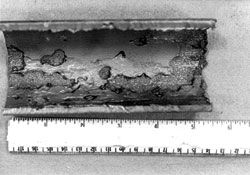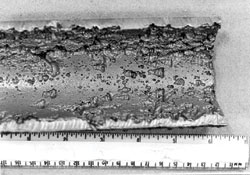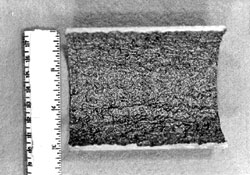What's new in production
Recent spills highlight benefits of pre-planning and corrosion control
Check your pipes. Recent pipeline failures in the frozen wastes of Alaska point out the serious problem that corrosion creates. Recall the oil leak in early March in Prudhoe Bay, covering three acres or so with around 4,700 bbl from a 1D4-in. hole in a 34-in. pipeline. A month later, another leak in Prudhoe Bay vented 12 Mcf of natural gas from a 3-in. pipe in a gas-lift system. Also in April, Kuparuk field experienced a leak that covered about 2,000 sq ft of tundra with 12 bbl of produced water, released from a hole in a 24-in. pipeline. You probably heard of the first one because of the Prudhoe Bay/ Alaska pipeline connection, but the others? I doubt it – they only got local coverage. However, they are the more common problems; relatively small leaks that seldom draw the world’s attention, but which can lead to large environmental problems, regulatory headaches and cleanup expenses. Equally important for the operator, leaks like these causes shut in production and postponed revenues. The larger Alaska pipeline leak interrupted cash flow to the tune of about $6 million per day. The gas release shut down production of 100,000 bopd and the produced water leak delayed production at the rate of 4,000 bopd. All of these releases were the result of internal corrosion, according to news reports. The Alaska pipeline operator was aware of the thinning steel, but considered the thinning manageable because of the pipeline’s low corrosion rate. No mention was made of the other operator’s knowledge of the condition of their gas-lift or produced-water facilities. Corrosion is a complicated electro-chemical interaction between produced fluids and the metallic structures that contain and direct the fluid flow from the reservoir to the holding tank. The electric potential between an oilfield tubular and a reservoir’s produced fluid changes with the ph of the fluid. The electric potential also fluctuates as the ionic fractions of CO2, H2S and O2 in the fluid stream change.
The electric potential sets up corrosion cells, similar to a battery, where electrons are freed from the metal. The electron movement releases a metal ion (Fe2+) into the fluid stream, corroding the metal. The freed metal ion may later precipitate out of solution as some form of scale. Meanwhile, the freed electrons react with ions in the fluid stream to form water (H2O), hydroxyl ions (OH-1) or hydrogen (H2), depending on whether the fluid is acidic or basic. These reactions take place at the grain boundaries on the metal’s surface, producing pitting (see figure) that can be uniform, localized (raindrop) or channelized (mesa). Many other corrosion patterns are possible depending on how the fluid moves through the pipe and on the condition of the metal. So, there are many ways in which corrosion can nibble at a pipe’s integrity. What can be done to slow the process? There are at least eight ways: treatment of the fluid stream by dehydration, corrosive gas removal, solids removal and chemical inhibition; metallic protection using sacrificial anodes, protective coatings or pipe liners; and upfront installation of special alloy pipe, usually for high H2S or CO2 operations. Each of these techniques has positive and negative attributes for the operator to consider. Most fields will need a combination of methods to protect the field’s metallic infrastructure. Monitoring and routine replacement of damaged infrastructure is necessary to avoid major unplanned interruptions in operations. Were any of the Alaskan operators at fault? No, they all had corrosion plans in place and in operation. Nature just threw them a curve and took advantage of weak spots in their oil, gas and water systems. The Alaska oil field systems have over 30 years of safe, environmentally friendly operation. Other mature areas of the world have upward of 50 years of operation, some with better records than others. The caution is that older installed systems need attention, and the high oil price environment is the time to schedule upgrades for older, potentially weak piping systems to avoid unplanned shutdowns, environmental headaches and extended production shut ins. So, check your pipes; everyone over 50 years old needs a good scoping. Mars returns. Repairs to Shell’s Mars platform will be finished this month, earlier than expected. Partial production should be restored by late May, according to Shell Exploration & Production. Purchasing the right pipeline repair equipment before the Gulf of Mexico hurricane hit in late August last year, as well as immediate and accurate damage assessment were two factors that put Shell ahead of schedule. The company was able to lease one of the two available barges that can move a toppled platform to shore. It was also able to gather a crew of 500, including engineers, geologists and technicians, to live on an adjacent ship to do the work. Shell’s estimates that, while it was in the hurricane’s eye, the Mars platform encountered 80-ft waves and up to 200-mph wind gusts for about four hours. The platform’s oil derrick blew away, and pipelines and the workover rig were damaged. There were no well problems; no oil was spilled and no gas was released. Mars produces about 5% of GOM daily output. Hurricane season starts June 1.
|
|||||||||||||
- What's new in production (February 2024)
- Prices and governmental policies combine to stymie Canadian upstream growth (February 2024)
- U.S. operators reduce activity as crude prices plunge (February 2024)
- U.S. producing gas wells increase despite low prices (February 2024)
- U.S. drilling: More of the same expected (February 2024)
- U.S. oil and natural gas production hits record highs (February 2024)
- Applying ultra-deep LWD resistivity technology successfully in a SAGD operation (May 2019)
- Adoption of wireless intelligent completions advances (May 2019)
- Majors double down as takeaway crunch eases (April 2019)
- What’s new in well logging and formation evaluation (April 2019)
- Qualification of a 20,000-psi subsea BOP: A collaborative approach (February 2019)
- ConocoPhillips’ Greg Leveille sees rapid trajectory of technical advancement continuing (February 2019)







